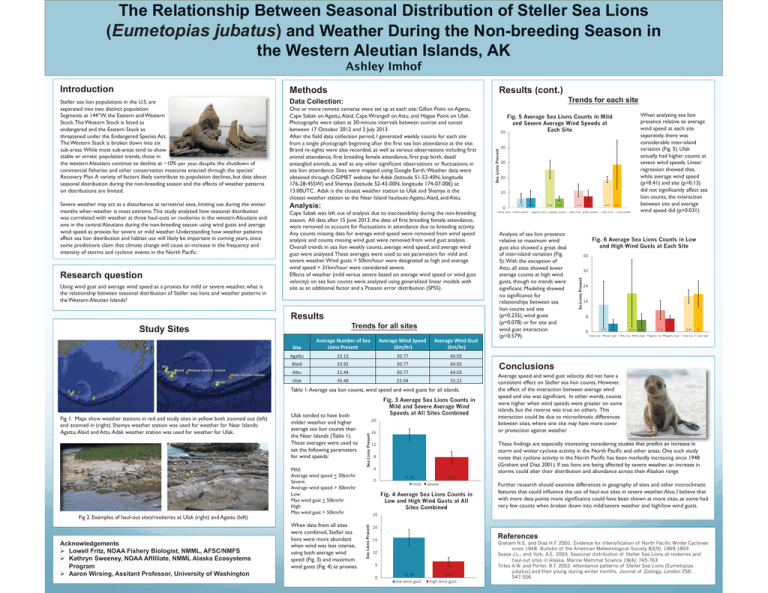Eumetopias jubatus
advertisement

The Relationship Between Seasonal Distribution of Steller Sea Lions (Eumetopias jubatus) and Weather During the Non-breeding Season in the Western Aleutian Islands, AK Ashley Imhof Introduction Methods Steller sea lion populations in the U.S. are separated into two distinct population Segments at 144°W, the Eastern and Western Stock. The Western Stock is listed as endangered and the Eastern Stock as threatened under the Endangered Species Act.. The Western Stock is broken down into six sub-areas. While most sub-areas tend to show stable or erratic population trends, those in the western Aleutians continue to decline at ~10% despite the shutdown off 10% per year, d it th h td commercial fisheries and other conservation measures enacted through the species’ Recovery Plan. A variety of factors likely contribute to population declines, but data about seasonal distribution during the non-breeding season and the effects of weather patterns on distributions are limited. Severe weather may act as a disturbance at terrestrial sites, limiting use during the winter months when weather is most extreme. This study analyzed how seasonal distribution was correlated with weather at three haul-outs or rookeries in the western Aleutians and one in the central Aleutians during the non-breeding season using wind gusts and average wind speed as proxies for severe or mild weather. Understanding how weather patterns affect sea lion distribution and habitat use will likely be important in coming years, since some predictions claim that climate change will cause an increase in the frequency and intensity of storms and cyclonic events in the North Pacific. Data Collection: Using wind gust and average wind speed as a proxies for mild or severe weather, what is the relationship between seasonal distribution of Steller sea lions and weather patterns in the Western Aleutian Islands? Trends for each site One or more remote cameras were set up at each site: Gillon Point on Agattu, Cape Sabak on Agattu, Alaid, Cape Wrangell on Attu, and Hagox Point on Ulak. Photographs were taken at 30-minute intervals between sunrise and sunset between 17 October 2012 and 2 July 2013. After the field data collection period, I generated weekly counts for each site from a single photograph beginning after the first sea lion attendance at the site. Brand re-sights were also recorded, as well as various observations including first animal attendance, first breeding female attendance, first pup birth, dead/ entangled animals, as well as any other significant observations or fluctuations in sea lion attendance. Sites were mapped using Google Earth. Weather data were obtained through OGIMET website for Adak (latitude 51-52-40N, longitude 176-28-45SW) and Shemya (latitude 52-43-00N, longitude 174-07-00E) at 13:00UTC. Adak is the closest weather station to Ulak and Shemya is the closest weather station to the Near Island haulouts: Agattu, Alaid, and Attu. Analysis: Cape Sabak was left out of analysis due to inaccessibility during the non-breeding season. All data after 15 June 2013, the date of first breeding female attendance, were removed to account for fluctuations in attendance due to breeding activity. Any counts missing data for average wind speed were removed from wind speed analysis and counts missing wind gust were removed from wind gust analysis. Overall trends in sea lion weekly counts, average wind speed, and average wind gust were analyzed. These averages were used to set parameters for mild and severe weather. Wind gusts > 50km/hour were designated as high and average wind speed > 31km/hour were considered severe. Effects of weather (mild versus severe based on average wind speed or wind gust velocity) on sea lion counts were analyzed using generalized linear models with site as an additional factor and a Poisson error distribution (SPSS). Results Trends for all sites Study Sites Table 1: Average sea lion counts, wind speed and wind gusts for all islands. Fig 2. Examples of haul-out sites/rookeries at Ulak (right) and Agattu (left) Acknowledgements Lowell Fritz, NOAA Fishery Biologist, NMML, AFSC/NMFS Kathryn Sweeney, NOAA Affilliate, NMML Alaska Ecosystems Program Aaron Wirsing, Assitant Professor, University of Washington Mild: Average wind speed < 30km/hr Severe: Average wind speed > 30km/hr Low: Max wind gust < 50km/hr High: Max wind gust > 50km/hr When data from all sites were combined, Steller sea lions were more abundant when wind was less intense, using both average wind speed (Fig. 3) and maximum wind gusts (Fig. 4) as proxies. 20 Sea Lions Present Ulak tended to have both milder weather and higher average sea lion counts than the Near Islands (Table 1). These averages were used to set the following parameters for wind speeds: 16 12 8 4 0 15.37 mild 7.84 severe Fig. 4 Average Sea Lions Counts in Low and High Wind Gusts at All Sites Combined 40 30 20 10 0 Alaid mild 6.25 Alaid severe 6.65 Agattu mild 25.44 6.21 Agattu severe Analysis of sea lion presence relative to maximum wind gust also showed a great deal of inter-island variation (Fig. 5). With the exception of Attu, all sites showed lower average counts at high wind gusts, though no trends were significant. Modeling showed no significance for relationships between sea lion counts and site (p=0.235), wind gusts (p=0.078) or for site and wind gust interaction (p=0.579). 11.52 Attu mild 7.93 18.75 Attu severe 28.67 Ulak mild Ulak severe Fig. 6 Average Sea Lions Counts in Low and High Wind Gusts at Each Site 40 32 24 16 8 0 14.33 Alaid low 4.41 Alaid high 20.25 Attu low 6.26 Attu high 11.36 Agattu low 6.91 Agattu high 18.69 Ulak low 20 Ulak high Conclusions Average speed and wind gust velocity did not have a consistent effect on Steller sea lion counts. However, the effect of the interaction between average wind speed and site was significant. In other words, counts were higher when wind speeds were greater on some islands, but the reverse was true on others. This interaction could be due to microclimatic differences between sites, where one site may have more cover or protection against weather These findings are especially interesting considering studies predict udies i that h pr edict di an iincrease ncrease in i storm and winter cyclone activity in the North Pacific and other areas. One such study notes that cyclone activity in the North Pacific has been markedly increasing since 1948 (Graham and Diaz 2001). If sea lions are being affected by severe weather, an increase in storms could alter their distribution and abundance across their Alaskan range Further research should examine differences in geography of sites and other microclimatic features that could influence the use of haul-out sites in severe weather. Also, I believe that with more data points more significance could have been shown at more sites, as some had very few counts when broken down into mild/severe weather and high/low wind gusts. 25 Sea Lions Present Fig 1. Maps show weather stations in red and study sites in yellow both zoomed out (left) and zoomed in (right). Shemya weather station was used for weather for Near Islands: Agattu, Alaid and Attu. Adak weather station was used for weather for Ulak. Fig. 3 Average Sea Lions Counts in Mild and Severe Average Wind Speeds at All Sites Combined 50 When analyzing sea lion presence relative to average wind speed at each site separately, there was considerable inter-island variation (Fig. 5). Ulak actually had higher counts at severe wind speeds. Linear regression showed that, while average wind speed (p=0.41) and site (p=0.13) did not significantly affect sea lion counts, the interaction between site and average wind speed did (p=0.031). Fig. 5 Average Sea Lions Counts in Mild and Severe Average Wind Speeds at Each Site Se Lions Present Research question Results (cont.) Sea Lions Present 20 References 15 10 5 0 15.95 low wind gust 6.42 high wind gust Graham N.E. and Diaz H.F. 2001. Evidence for Intensification of North Pacific Winter Cyclones since 1948. Bulletin of the American Meteorological Society 82(9): 1869-1893 Sease J.L., and York, A.E. 2003. Seasonal distribution of Steller Sea Lions at rookeries and haul-out sites in Alaska. Marine Mammal Science 19(4): 745-763 Trites A.W. and Porter, B.T. 2002. Attendance patterns of Steller Sea Lions (Eumetopias jubatus) and their young during winter months. Journal of Zoology, London 256: 547-556





